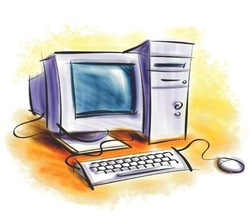Secondary Memory
Secondary Memory
This type of memory is also known as external memory or non-volatile. It is slower than main memory. These are used for storing data/Information permanently. CPU directly does not access these memories instead they are accessed via input-output routines. Contents of secondary memories are first transferred to main memory, and then CPU can access it.
In this type of memory the cost per bit of storage is low. However, the operating speed is slower than that of the primary storage. Huge volume of data are stored here on permanent basis and transferred to the primary storage as and when required.
Main secoundry memory are:
1. Magnetic Disk
2. Floppy Disk
3. Hard Disk
4. Optical Disks
Magnetic Disk
The Magnetic Disk is Flat, circular platter with metallic coating that is rotated beneath read/write heads. It is a Random access device; read/write head can be moved to any location on the platter
Floppy Disk
These are small removable disks that are plastic coated with magnetic recording material. Floppy disks are typically 3.5″ in size (diameter) and can hold 1.44 MB of data. This portable storage device is a rewritable media and can be reused a number of times. Floppy disks are commonly used to move files between different computers. The main disadvantage of floppy disks is that they can be damaged easily and, therefore, are not very reliable. The following figure shows an example of the floppy disk. Figure 3 shows a picture of the floppy disk.
Hard Disk
Another form of auxiliary storage is a hard disk. A hard disk consists of one or more rigid metal plates coated with a metal oxide material that allows data to be magnetically recorded on the surface of the platters. The hard disk platters spin at 5 a high rate of speed, typically 5400 to 7200 revolutions per minute (RPM).Storage capacities of hard disks for personal computers range from 10 GB to 120 GB (one billion bytes are called a gigabyte).
Optical Disks
Optical Mass Storage Devices Store bit values as variations in light reflection. They have higher area density & longer data life than magnetic storage. They are also Standardized and relatively inexpensive. Their Uses: read-only storage with low performance requirements, applications with high capacity requirements & where portability in a standardized format is needed.
Types of Optical Disk
1. CD-ROM (read only)
2. CD-R: (record) to a CD
3. CD-RW: can write and erase CD to reuse it (re-writable)
4. DVD(Digital Video Disk)
